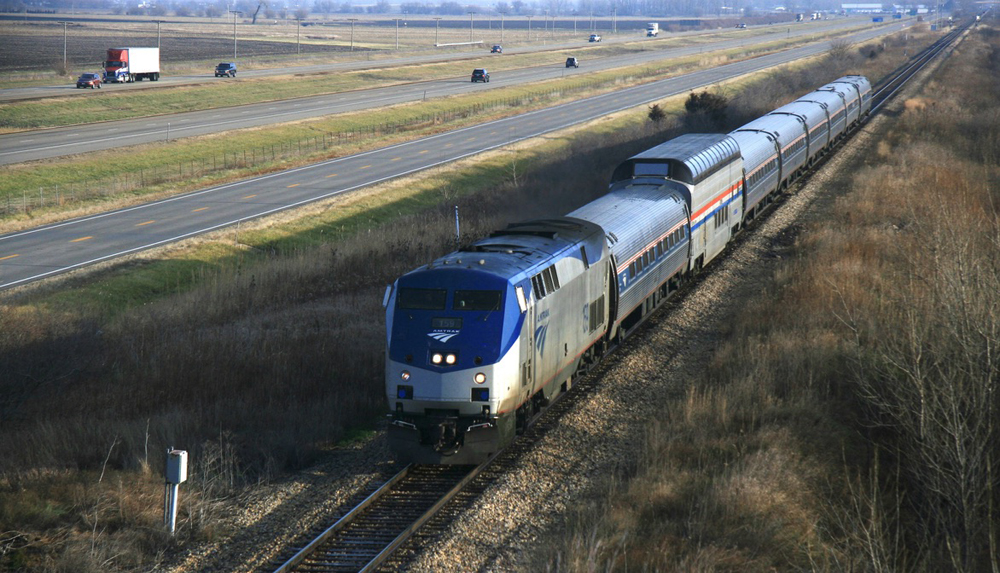
WASHINGTON — Consistent sellouts on Amtrak trains before and after Thanksgiving never get the same media play as TV reporters provide with stand-ups at the airport or on a highway overpass, and 2022 was no exception. The ability to efficiently move masses of travelers is a story that needs to be told.
What was different at Amtrak this year, however, is that the company not only wasn’t able to add extra holiday departures to accommodate the usual demand surge, but didn’t even have enough equipment and crews to operate its regular daily schedule on several Midwest routes.
Sold out in the Midwest, East, and Pacific Northwest
A Trains News Wire spot check of all corridors and long-distance routes beginning early Thanksgiving week for travel the Wednesday before and Sunday after the holiday showed widespread sellouts outside of California, North Carolina, Virginia, and Maine. Any remaining coach inventory was subsequently gobbled up, especially on Sunday.
In previous, pre-pandemic Thanksgiving weekends, the company squeezed extra round trips out of its equipment and crews on routes between Chicago and Quincy and Bloomington-Normal, Ill.; and Ann Arbor and Holland, Mich. Extra equipment was also pressed into service on many routes. This year, morning trains to and from Quincy, and one Chicago-Carbondale round trip are cancelled through mid-December, as is one St. Louis-Kansas City, Mo., round trip. All Wednesday and Sunday trains except unreserved Chicago-Milwaukee Hiawathas were sold out, as were coach seats on every long-distance train that shares corridor routes.
Amtrak was able to charter on-time buses Wednesday to handle St. Paul-Chicago Empire Builder passengers booked on an eastbound train running more than 7 hours late, but the only space available on other Wednesday and Sunday Builders cost $385 for one adult in a roomette.
Coast Starlight roomettes could also be purchased between Seattle and Portland, Ore., but no coach seats were available on any other train, even though an extra round trip on both Wednesday and Sunday was achieved by turning equipment out of the usual pattern. Aside from the two Talgo Series 8 trainsets that normally do Seattle-Eugene, Ore., trips on trains 500 and 505, the four Horizon equipment sets are each assigned just two coaches and one café-business class car.
Northeast fare manipulation garners extra revenue
For decades, Amtrak leased commuter trainsets from Philadelphia’s SEPTA, Maryland’s MARC, and NJ Transit south of New York to accommodate legions of travelers headed home and back. Extra round trips with Amfleet coaches and staffed cafe cars were also added as advance sections to especially taxed Boston-Washington trains that operated into Virginia. Special Thanksgiving timetables providing a much-appreciated scorecard while promoting the additional capacity.
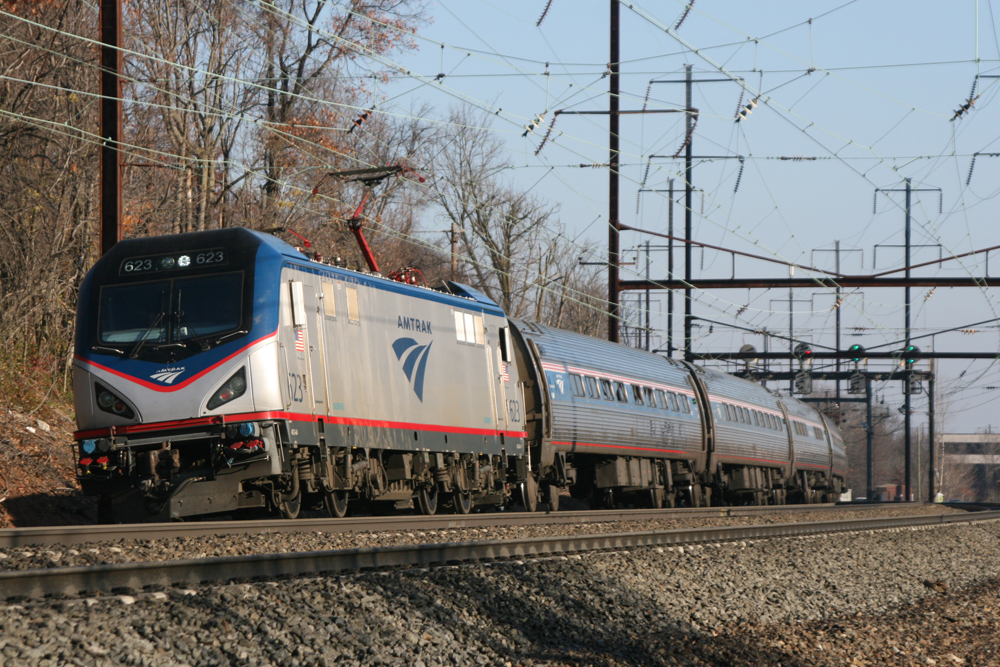
Not so today. The only extra trains operating across the long weekend were two Boston-Washington Acela round trips on Sunday, Nov. 27, and another Washington-New York Acela round trip extended from New York to Boston that day.
One justifiable reason is that travel patterns became less regimented over the last few years as more flexible employment arrangements evolved. However, the most significant factors are insufficient operating and maintenance employees and sidelined equipment that management did not sufficiently prioritize returning to service.
Given this reduced capacity and to avoid sellouts, Amtrak has intensified its use of yield management to dramatically raise prices as seats are booked over time. A News Wire snapshot on Tuesday, Nov. 22, of departures for Sunday, Nov., 27, showed the following:
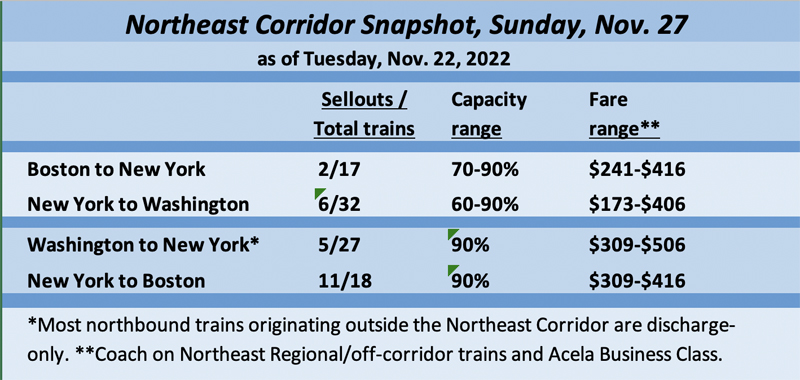
Despite the prices, most remaining seats were sold by the time Northeast Regionals and Acelas left their terminals on Sunday. Although Pennsylvania’s Harrisburg-Philadelphia-New York Keystones had inventory, most Empire Service trains were sold out well in advance.
On the Sunday after Thanksgiving in 2013, Amtrak originated 25 trains, with 20 sellouts from Boston to New York’s Penn Station tallied the day before. From New York’s Penn Station to Washington, 44 trains operated with 14 sellouts. On trains that still had seats as of that Saturday, New York-Washington pricing ranged from $84 for end-of-day trips to $264 for Acela business class. Of course, inflation has taken a toll in the intervening years, but the additional trains were able to accommodate thousands more passengers.
That said, this year Amtrak’s network dependably carried huge numbers of travelers to their destinations over the holiday, especially in the face of heavy rain in the Northeast and mid-South that disrupted air and highway journeys. The only significant delays across the system were Saturday eastbound departures of both the California Zephyr and Cardinal. Perhaps someday, and with more rail options, Amtrak’s big Thanksgiving won’t operate in the shadows.






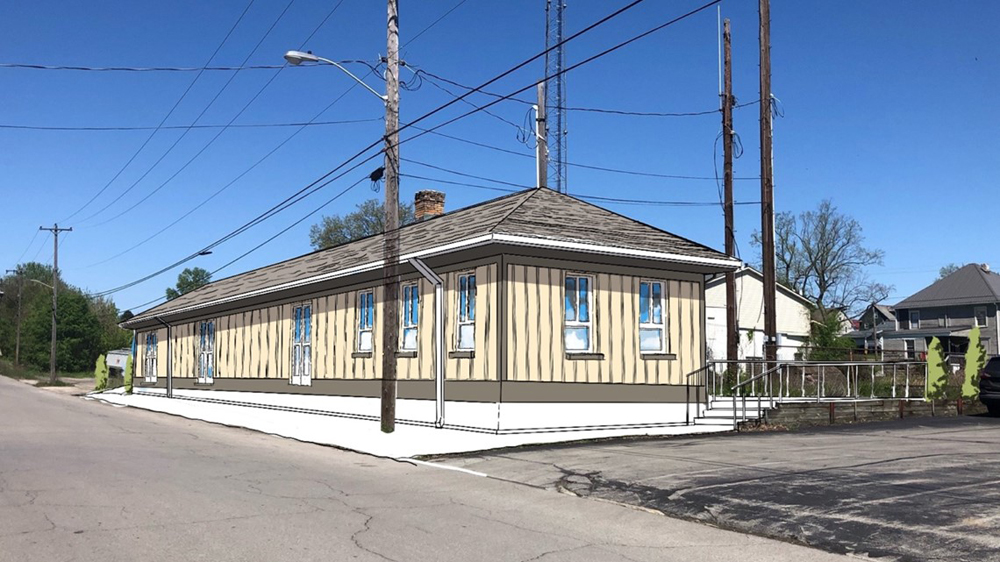
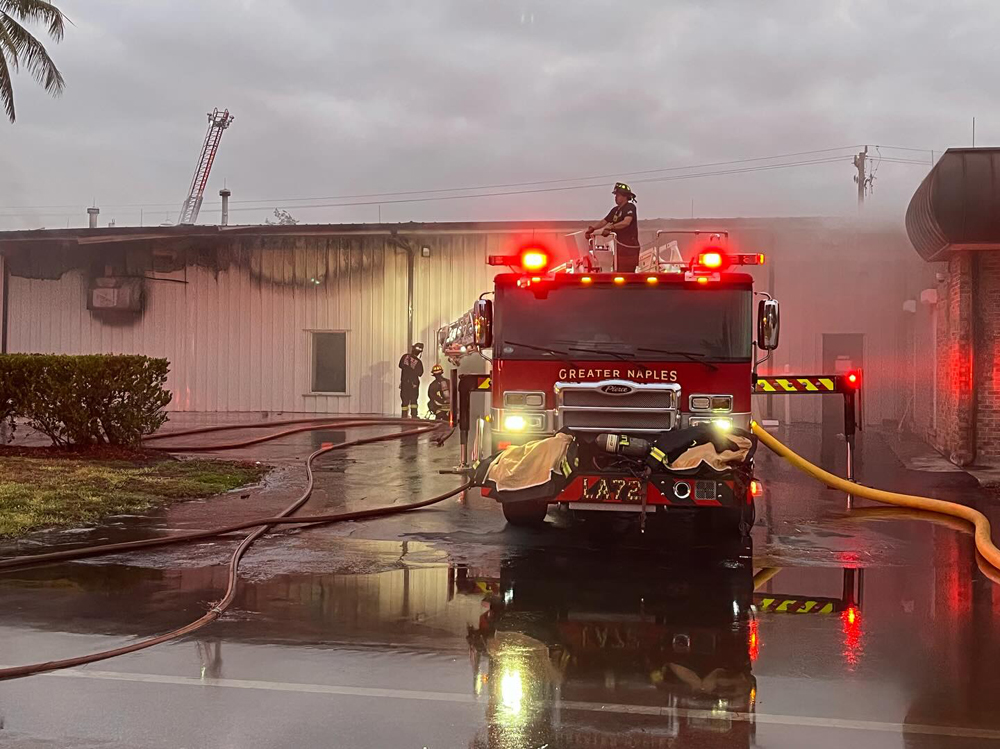
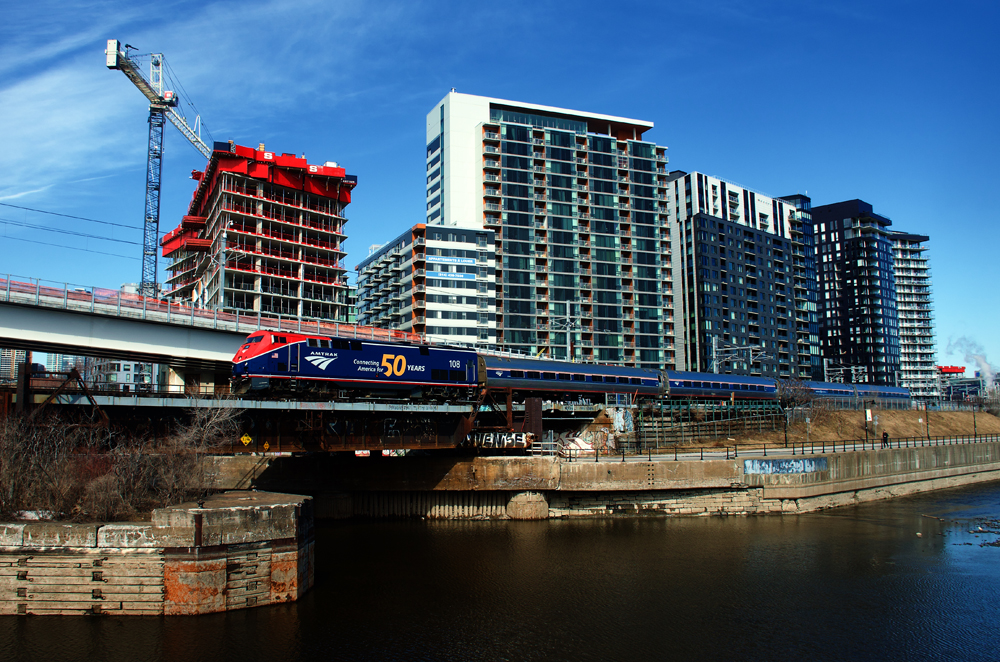
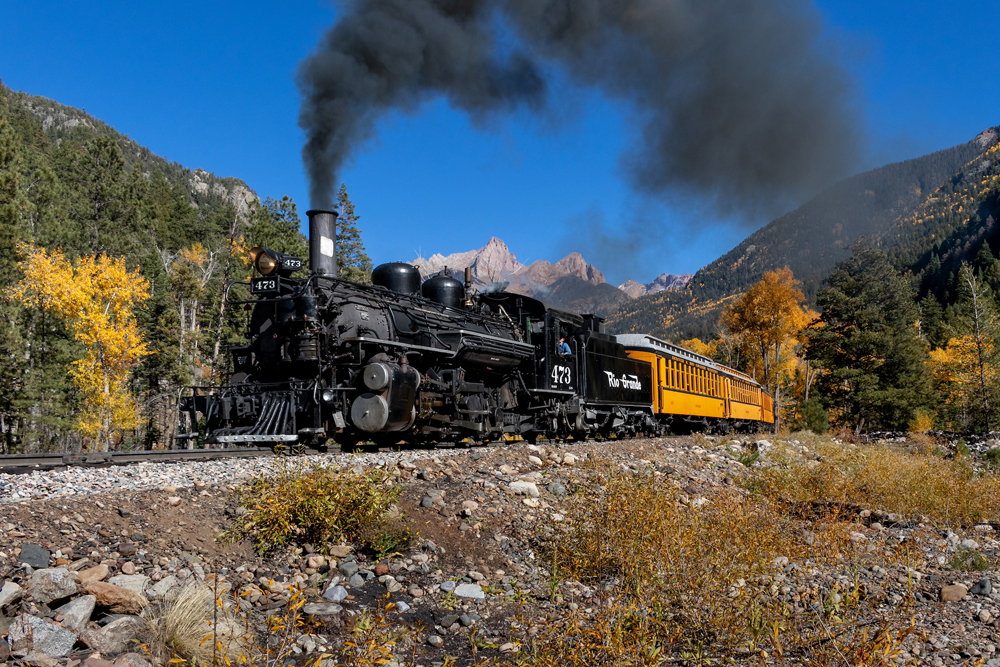




It is time For Amtrak to look ahead instead of cutting service. They bought new short haul coaches and engines for the mid west short haul trains but could not deliver the service those trains should have been able to deliver. If the problem is the manufacture of those cars and engines the company providing them should pay Amtrak for their unavailability. The management also needs to be held responsible for not hiring enough staff to run the trains. No bonus should be paid for poor performance. Amtrak is hurting their bottom line by not having enough capacity.
I just want to add more post regarding this story ….TV news reporters and the media in general did a very poor job of covering rail travel over the holiday weekend. Plenty of coverage at the nation’s airports and highways of folks traveling to their destinations by either plane or car but virtually nothing on train travel. Even in New York City no coverage or mention of the thousands of travellers passing through or waiting for trains at Penn Station or Grand Central Terminal. If we didn’t know otherwise, we would think that train travel ceased to exist in this country. TV news is one sided and biased against train travel and railroads in general with their coverage. However whenever there is an accident or a derailment somewhere involving a passenger train or freight, TV news is quick to cover that or post ome negative aspect of rail travel and TV news never gives an accurate account or the right information about the hows and whys of rail operations. Even railfans and model railroaders get negative coverage and reporting on TV news when something pops up about our hobby or interst. It is time for the media and TV news to give and report fairly on the rail industry and don’t either ignoreit or think of trains as a joke or something from the past.
Joseph C. Markfelder
Mr Dupee- I agree with your comments in the above post 100 percent. As I have mentioned in some previous posts , This country needs all forms of transportation Rail, road, air and water. A country that solely relies on just one or two forms of transportation to get somewhere is doomed to experience collapse and confusion since one or two forms of travel cannot handle the vast influx of passengers and travellers. Cohesion and cooperation between all forms of transportation is needed and also includes having and hiring the right people for the job plus some new and inovative ideas in marketing strategy and bringing aboard a new generation of bright young minds to pursue the goal of a complete and comprehensive transportation system where all forms work together to move the public and goods. If we can time and money on building rockets and vehicles to go to the moon and Mars, look how we can turn that tecnology and know how into building and improving our transportation network here on Earth with only a fraction of the cost it takes to fly to the moon.
Joseph C. Markfelder
Pre-Amtrak I went on the day before Thanksgiving to Newark and Downtown NY. Plan was the Midday Congressional. Reality was an advance section consisting of MP54 MU Cars. It was exhilirating riding those cars at full speed. In a window seat.
But 28-29 were all-Pullman then.
If I could only find a store that sold coal, I would send 2 giant lumps of coal to Gardner and Coscia for their totally pathetic, irresponsible decision to in essence close the system by employee furloughs or terminations in response to the pandemic. Obviously, this decision was jointly made without regard to how employees would be brought back, nor the cost of recruitment and training new staff; let alone, how would equipment be maintained.
As loyal Democrats, I gather these 2 “leaders” inexperienced in passenger rail operations ride the coattails of Biden and Schumer, assuring their immunity to even the most remote sense of accountability. This is THE explanation for cancelled corridor trains, short consists, short staff, storage of new Siemens cars, frequent breakdown of new Siemens diesels; inability of quick turns of equipment to serve holiday crowds.
Such a persistent record of unforced errors cannot be perpetrated by the new Congress. Instead, Coscia and Gardner must be taken to the woodshed to explain how does such a group of inexperienced corporate management and Board qualify for the cover of MAD magazine, let alone bonuses? Also, Congress must clarify and diminish Amtrak’s false, self-declared claim of having a monopoly on all corridor and long distance routes, operational or not. Instead, FRA/DOT should have the power to vet qualified operators (with a proven track record), what FRA-approved equipment to be used, and how trains would be staffed (union).
In this manner, although we may never return to the pre/post Thanksgiving during the mid-1960s when the B&O added 8 coaches to the “Capitol Limited,” but sufficient capacity will be provided; “enlightened” management easily implementing seat reservations, serving coach passengers in the dining car, club cars attendants trained in mixology to competently craft cocktails (as the railroads used to do everyday).
Nothing will change until Congress exercises its power. But first, it must have knowledge of how bad it all is, starting with the failure to properly operate during the pandemic despite taking millions in relief; bonuses for just showing up.
Mr. Singer, walk down any railroad tracks that has coal cars travel down them and you should find coal block aplenty. I have a local route that takes coal cars to our papermill daily and you can walk the line (I know, it’s trespassing but as a kid I didn’t care) and find coal just about anywhere. Especially in the small yard in my hometown.
I’ve even found lumps of coal in my yard while cutting grass as it is kicked up by the lawnmower. As I’m told by the old timers, this area stored coal for the railroad before housed were built here.
Keep in mind that ‘Loyal Republicans’ have been attempting to eliminate Amtrak altogether for decades. The issue is Congress should not be in the railroad business, regardless of the party in power.
Many in the GOP make it their mission to try to kill Amtrak funding on a routine basis while exaggerating its pittance to the public. One year of FAA funding is more than 51 years of Amtrak. Same GOP that cuts taxes primarily on the wealthy and then claim NPR and PBS cost “a fortune.” Bias and corroboration are lost right of the aisle. And with MAGA whackos honesty and the republic have been replaced by idol worship and pure invention.
With all of the news reports showing TSA lines backing up all over various airports on Sunday, some even out the front door(!) of the airport, you would think Amtrak would be primed, ready and rolling for a holiday crush.
This actual response just amplifies my horn to get Amtrak to start bidding off service segments and let the private sector make offers to fill in the service gaps.
Your idea of Amtrak subletting routes to interested private entities is a very good idea that should be seriously considered and examined. I am told that some railroads seem willing to work with an operator other than Amtrak.
As presently arranged, Amtrak tries be a national railroad running a far-flung system with not enough financial resources and plenty of political interference. It might be better if Amtrak was simply a coordinator for services directly run by other interests.
Correction: FDOT should be USDOT.
All of us here must recognize and take into consideration that rail passenger service is not inferior to the other modes. It has its place in the grand scheme of things, including the national network.
The reason for its decline has less to do with a lack of demand (there’s a lot of that) than the fact that several factors work against its expansion. Imagine any business that has to pay taxes on its property, being in direct competition with another that does not. On top of that, the competitor never has to concern itself with the cost of infrastructure expansion, which is borne by the public.
This is exactly the case with rail vs. highway, or rail vs. bus, or rail vs. airline.
This incongruity has been recognized by transportation planners for many decades, but entrenched factions make it extremely difficult to correct. The entire reason that the old Federal Highway Administration was succeeded by the FDOT was to make the agency more broad based to include all modes in planning and funding. Still, the highways and airports get the lion’s share and the rails get the crumbs.
Europe actually did include rail in their long term planning and funding. The results are testament to their success.
Yes. Our freight rail is private and strong. But we all have witnessed how deregulation gutted the network and led to a “bottom line” priority sacrificing customer needs in the pursuit.
We don’t need a national passenger rail system. We need better passenger rail where it makes sense, which is in relatively short, high-density corridors where the cost to expand the highways and airways is prohibitive.
Let’s look at reality:
(1) United States. Remember when Amtrak started in 1971. Since 1971, several routes have been abandoned, single-tracked, speed restricted or downgraded. Other routes have become much more congested with frieghts because of the abandonment of parallel lines. We no longer have an infrastructure for a national passenger rail system.
(2) Canada. What would be VIA Rails weekly train miles compared to when it started? As an informed guess I’d say somewhere around 20%.
Face it folks, America and Canada both, the battle has been joined, has been fought, and has been lost. We’re in disarrayed retreat. VIA and Amtrak both have done as much to kill off the passenger train as did the private railroads before them.
Charles – While I agree with your post, I’m personally weary of your pounding the same talking point ad nauseum. Please, give it a rest. Bob Johnston has fresh data with each post. You don’t. Back in the day of the Ford Tri-Motor (no, I wasn’t there) I’m sure the railroad folks pointed out that the planes were few and far between, but the trains had multiple platforms and hundreds of departures at hundreds of cities. I get it.
Fine article (as always) Bob. I remember those days, when we’d read in TRAINS MAG that Amtrak pressed commuter cars into service after TG. Good show back then. Not so much these days
DEN Denver International Airport, “C” Concourse, the highest-numbered gate is C99. Which I assume (but don’t actually know for certain) means 99 gates at that concourse, which is one of three concourses at DEN. How many platforms does Amtrak use at Denver Union Station?
I didn’t obsess reading the monitors at DEN as I sometimes do at various airports. The little I did look at the monitors I noticed no cancelled flights, the Saturday after TG.
Being picked up at DEN is simply impossible, with thousands of arriving airline passengers looking for their rides. Arriving at DEN the Monday before the holiday, I was told to ride the Light Rail one stop out of the airport to be picked up. That Light Rail stop was all but deserted. Three automobiles came to pick up passengers, me being one. I expected much bigger crowds on the Light Rail but this didn’t happen.
One correction Charles, the tail line out of DIA is actually refered to has commuter rail. It differs from heavy rail as the grades are steeper and the curves tighter. This was done as the system shares a right of way with the UPRR closer to Denver. Got this info from a former FRA safety official.